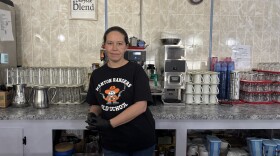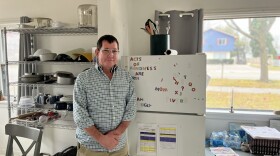This reporting is made possible through a partnership between IPR and Grist, a nonprofit environmental media organization.
Home to more than 14,000 people, it’s known for the Porcupine Mountains Wilderness State Park, affectionately called the Porkies, which spans about 60,000 acres. There’s North America’s largest ski jump, resorts and a natural landscape prized across the region.
It also holds a massive copper deposit, called Copperwood, where developers hope to mine tens of millions of pounds of copper a year — the contents of which could play a role in the move toward renewable energy.
As the state considers whether to grant a new air use permit for the proposed copper mine, there’s concern from people involved in the longstanding debate over whether the mine should be built.
And now the public is weighing in as two different sets of environmental goals collide in one of Michigan’s most remote and natural places.
The proposal
Copperwood Resources Inc., the U.S.-based subsidiary of the Canadian company Highland Copper, plans to dig an underground mine and process that ore nearby. It would operate less than two miles from Lake Superior, partly extending under the Porkies and bordering the North Country Trail.
The mine would be built on land Ojibwe nations ceded to the United States in the 1842 Treaty of La Pointe, stoking concerns that potential contamination could threaten the rights of Anishinaabe people to hunt, fish, and gather on ceded territory.
Now, EGLE’s Air Quality Division is taking public comment on its proposed air use permit for the mine. It’s meant to ensure that Copperwood’s emissions meet federal and state air quality rules and regulations. EGLE says for this permit, it only looks at state and federal air quality standards, and not at other things that have been part of the public debate, like zoning, noise, light and traffic — or whether the project is needed in the first place.
Permitting for the mine has gone on for more than a decade, including multiple air quality permits from the state Department of Environment, Great Lakes and Energy. The last one expired in 2023.
Your thoughts?
Public comment on EGLE's proposed air use permit for the Copperwood Mine has been extended through December 3.
Mine emissions
EGLE’s draft air use permit considered emissions from activities like venting out the underground mine, processing the ore, and heating the facility.
The proposed permit directs the mining company to limit emissions from the underground vents, limit the size of the mine’s heaters and the type of fuel they use, suppress dust, and enclose areas where the mining materials would be stored and processed. They’d also have to do some regular testing.
According to EGLE, the mine would emit contaminants like relatively small amounts of heavy metals into the air, as well as gasses like carbon monoxide, oxides of nitrogen, formaldehyde and sulfur dioxide. It would also release fugitive emissions — things that don’t come directly from an exhaust stack, like dust.
The agency considers Copperwood’s potential emissions to be “minor” based on national standards from the Environmental Protection Agency. It says the mine would meet state and federal standards for health, like the federal National Ambient Air Quality Standards and the state’s rules on toxic air contaminants that could cause problems, like respiratory issues or cancer.
Copperwood’s permit materials are posted on EGLE’s website
Emissions modeling
EGLE used computer modeling to predict the concentration of emissions, and how the mine would affect the area’s air quality and people’s health.
It gathered baseline data from air monitoring stations in Wisconsin’s Forest County and a small town near Milwaukee, since they are among the closest to the site. There are no monitors at the Copperwood site in Michigan, and there are no requirements to install one there, should the mine be built.
Fugitive emissions — those that don’t come from an exhaust stack — are another consideration.
“We're always looking for dust, so that's a huge one,” said Joe Scanlan, the state air quality inspector for this project, during the public meeting on the air permit.
“These are part of the reasons why we go unannounced, because we want to make sure that they're doing all of their fugitive dust monitoring and being in compliance with that stuff,” he said.

Deep public concern
None of the 20-some people who spoke at a virtual public hearing last week supported the mine, and many said the air permitting process wasn’t enough to protect the area or the people there.
Highland Copper declined to comment for this story, citing a wish to let EGLE’s permitting process play out.
During the hearing, people raised concerns about the mine harming air quality. (Groups against Copperwood have pointed to vents near the state park.) They questioned how the baseline air quality was determined. Some worried about noise and light pollution, which aren’t considered in EGLE’s air use permit. Others asked about tribal consultation and cultural surveys.
And there were concerns about the scope of the permitting process. Nichole Keway Biber, a tribal citizen of the Little Traverse Bay Bands of Odawa Indians, said the process was essentially asking “what amount of ruination is acceptable?” She spoke about the impact on the overall environment, including wildlife.
“It's not only the lungs of humans that are going to be affected. It's not only the air of the human community that's going to be affected,” she said. “So I just want to say the risks and effects that are unknown in this should be a denial of the permit, because we need to kind of change the way that these standards are understood.”
EGLE officials said they’re bound to follow a particular process, and that people unhappy with it should contact their legislative representatives, who set the laws they have to follow.
One theme that held steady throughout public comment was how special the area was; many said it should be evaluated differently because of its old-growth forests, proximity to Lake Superior, and other environmental factors. The idea was that there should be an exception for places like the area where Copperwood would be built.
“Somehow, allowances need to be made to consider the notion of taking an undeveloped old-growth forest and installing a mine under it and next to it, and how that will be taking virgin air quality into a place that it's never been and would not have gone,” said Johnson Bridgwater, who lives in Gogebic County.
People also questioned how environmental justice considerations factored into the permit, and whether there were special considerations for areas with so much natural habitat.
“Right now, we do not have any environmental justice regulations in Michigan, not specifically environmental justice related,” said EGLE’s Jenifer Dixon ahead of the hearing, referring to the air permit. While not bound by regulation, a section on environmental justice in the project summary points to guidance about how it is considered.
Long legacy, uncertain future
Copperwood is part of a rush of mining endeavors in the Upper Peninsula, spurred on by the push to tackle climate change through electrification. To meet clean energy goals and cut back emissions, the world will need a lot more materials like copper, which is used in technologies like wind turbines.
And while critics are concerned about the environment, so are proponents.
“If we don't mine these metals, we will not reduce our emissions. We just can't,” said Adam Simon, a professor of earth and environmental sciences at the University of Michigan, speaking to IPR’s Points North podcast earlier this year.
This touches on deeper questions around how the country moves forward; as governments and companies pursue more renewable energy projects, tribal nations have fought to exert their sovereignty in the face of things like copper mines and major solar panel installations on tribal lands.
Previous mining in the Keweenaw has left dangerous reminders of the threat they pose, like elements such as arsenic and mercury in wild rice beds in and around the Keweenaw Bay Indian Community’s reservation.
Copperwood’s supporters include many local governments, which hold that it’s necessary to bolster the region’s economy. The state says it would result in 380 mining jobs and 300 construction jobs, along with millions of dollars in local, county and state revenue each year.
Gov. Gretchen Whitmer’s administration supports the mine; the Michigan Strategic Fund approved a conditional $50 million for the project last spring, although the legislature failed to approve it last session.
State officials, meanwhile, don’t have a firm timeline for a decision on the air permit after the comment period ends.






